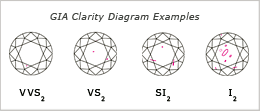
- Canary diamonds - a common term used to describe a yellow diamond.
However, it is not a technical term that you will see on a GIA (or any other lab's) grading report. GIA uses terms, such as fancy light yellow, fancy yellow, fancy intense yellow and fancy vivid yellow, among others.
- Cape diamonds - generally within the range of M to Z on the color grading scale.
Again, this is not a technical term used on GIA grading reports.
- Carat weight - the measure of weight of a diamond.
It should not be confused with karat (the measure of the purity of gold). The name Carat is derived from the carob seed, which, given its fairly uniform size, was used hundreds of years ago to weigh diamonds and other precious stones. Given the imprecise nature of this measure of weight, a standardized measure of the carat was developed and is now the standard world wide weight measure for diamonds. A carat is equal to 0.2 grams.
- Carbon Spots - common term for black or dark inclusions in a diamond.
The technical name for them is black pique. Black pique are more detrimental to a diamond's value than white or clear imperfections, as they are often more eye visible.
- Cavity - An open imperfection in a diamond.
- Certificate - Some labs refer to their grading reports as certificates.
They are often laminated (for longevity and to prevent tampering) and provide written documentation of the diamond's natural occurrence, weight, proportions, color grade, clarity grade, cut grade, and other characteristics and qualities of the diamond, including any treatments.
- Chip - an inclusion on the surface of the diamond where a piece of the diamond has broken off.
This can be quite detrimental to the value of the diamond, as the diamond needs re-cutting to return it to its original state. This can lead to the diamond 'breaking its weight' (going below important or magic weight levels, such a 1.00 cts).
- Clarity - a diamonds relative lack of clarity characteristics.
Inclusions (fully enclosed within the diamond) and blemishes (surface imperfections) determine clarity. A clarity grade is determined by the overall effect of the clarity characteristics. Specifically, the size, number, position, nature and relief of the characteristics are all factors.


